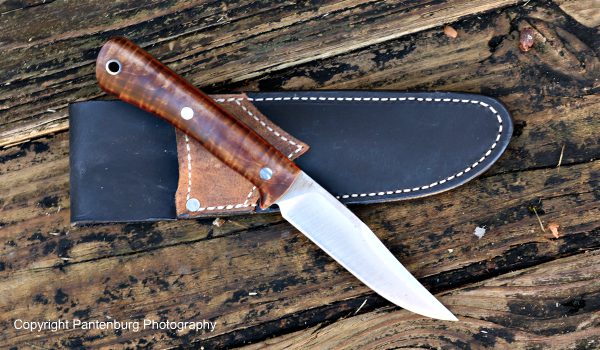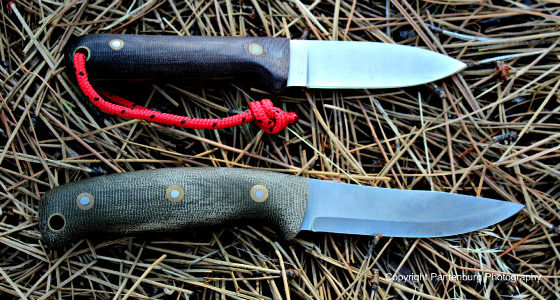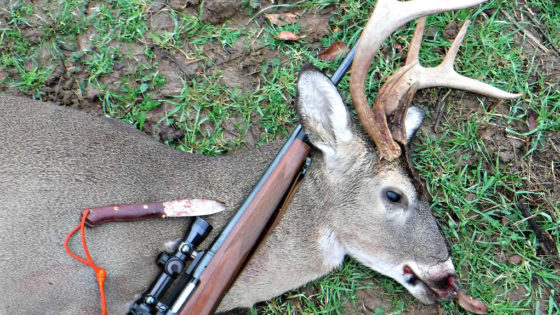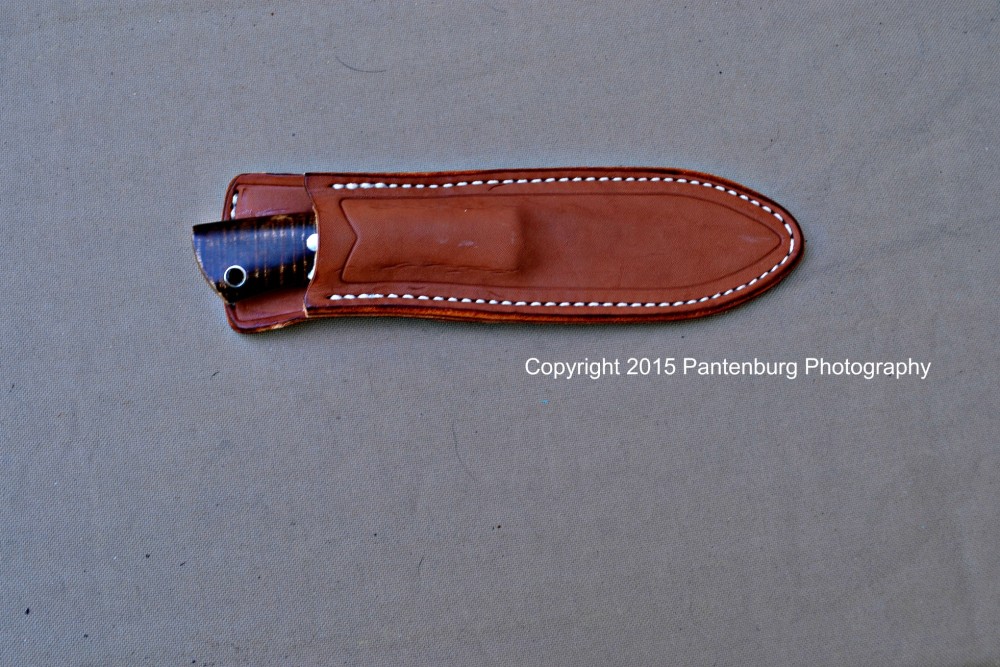Combine a classic design with hand-forged quality and superior steel and you get the Lon Humphrey Minuteman.
You also get my money. There is a lot to like about this knife.
by Leon Pantenburg
My inability to pass up a quality knife with a classic design and modern materials may be too well known. At any rate, these custom knife makers keep coming up with products I can’t seem to resist.

The Minuteman’s generous, well-designed handle makes it easy to use.
The Minuteman is one of those knives. It combines some of my favorite cutlery features with modern materials. But is is also a handy, lightweight knife that rode in my daypack most of the summer in hikes in the Oregon Cascades. As such, it was used for whittling sticks, cutting summer sausage, spreading peanut butter and everything a user knife is carried for. It worked great.
Lon Humphrey Knives: Minuteman 3V
Specifications (Courtesy of Knivesshipfree.com)
| Overall Length: | 9.25″ |
| Blade Length: | 4.5″ |
| Blade Steel: | CPM-3V |
| Blade Thickness: | .150″ |
| Weight: | 5.1oz. |
Features
| Made in USA |
| High-quality leather sheath included |
The good stuff
Point: The point helps determine how useful the knife will be. My favorite all-around point is probably the clip point with a swedge. IMHO, the clip is the most useful because it has a narrow point for piercing (think under-the-tail work of field dressing a whitetail), good belly for skinning, and a centered point that helps you avoid piercing the entrails while making the initial spine-down, edge-up cut that opens up the abdomen of a big game animal.
That said, I also regularly use spear and drop points. The task will determine the best point and generally, you can’t go wrong with a clip point.
Steel: The blade comes in CPM-3v, which is one of my favorites. Under normal use, such as in deer hunting, the blade will seldom need sharpening. On several occasions, I have gutted, split the ribcage, skinned and quartered a whitetail with a CPM-3V blade without the edge ever needing a touchup. Sharpening CPM-3V is not as difficult as some might think. A smooth river rock will work as a sharpening stone in a pinch.
Choil: There isn’t one! Choils are another one of those knife fads that needs to go away. I don’t choke up on a blade when using the knife – if I have to, IMO, that is the sign of a poorly-designed handle, or that I picked the wrong knife for the job. (Here is how to use a choil correctly.)
Handle: I wear size large gloves, and my right palm measures a little over four-inches across. A useable handle for me must be a minimum of four inches long. It also must be thick enough for me to get a good handful. The Minuteman handle is both long enough and thick enough. I also like the curly maple handle.

The handle works well with this pinch grip.
While micarta is a more durable, stable handle material than maple, just how much strength do you really need? Wooden handles have been used for eons, and many of my hard user knives have wooden handles.
Grind: A flat grind with a micro bevel is a very useful grind. This is a good slicer, and it worked well in camp for various food and fire making tasks.
Weight: at 5.1 ounces, this knife is hardly noticeable when carried. It rode for many miles last summer in my daypack, and the weight is inconsequential. A knife that easy and comfortable to carry is one that won’t be left in the vehicle at the trailhead.
Sheath: The leather sheath is well made and very good looking. It protects the blade, as well as the user. It rides at a nice level on my belt.
Blade thickness: I understand that knife makers have to cater to a large audience, and they must make a product that will appeal to the largest cross-section of consumers. The trend in recent years was toward thicker blades, but I think that is turning around as people actually use the knives they are buying. (Check out this post regarding thick knife blades from Mike Stewart, president of Bark River Knives.)
The original mountain man knives had thin blades. The Minuteman’s blade, at .150-inch, works fine, but if would work better if it was about .125-inch or possibly .10. I don’t baton firewood (I have axes and hatchets for that) and I don’t pry stuff. Those are the only reasons you might need a thick blade in the field. As a seasoned outdoors type, I have used knives in the outdoors for well over a half century in sometimes extreme conditions. I have never broken a blade. The Minuteman with a thinner blade would be lighter, more nimble in the hand and cut better.
Do you need a Minuteman?
Here are some added reasons I like this knife.
Made in the USA: All Lon Humphrey knives are made here, by skilled American craftspeople. They all make a living wage, pay local, state and federal taxes, and contribute to their communities.
Local control: If you ever have a problem with a Lon Humphrey knife, you can call the shop and talk directly with the person who worked on your knife. Every dealing I’ve ever had with the company has been pleasant and positive.
This knife is a keeper.
Please click here to check out and subscribe to the SurvivalCommonSense.com YouTube channel, and here to subscribe to our email newsletter!






Leave a Reply